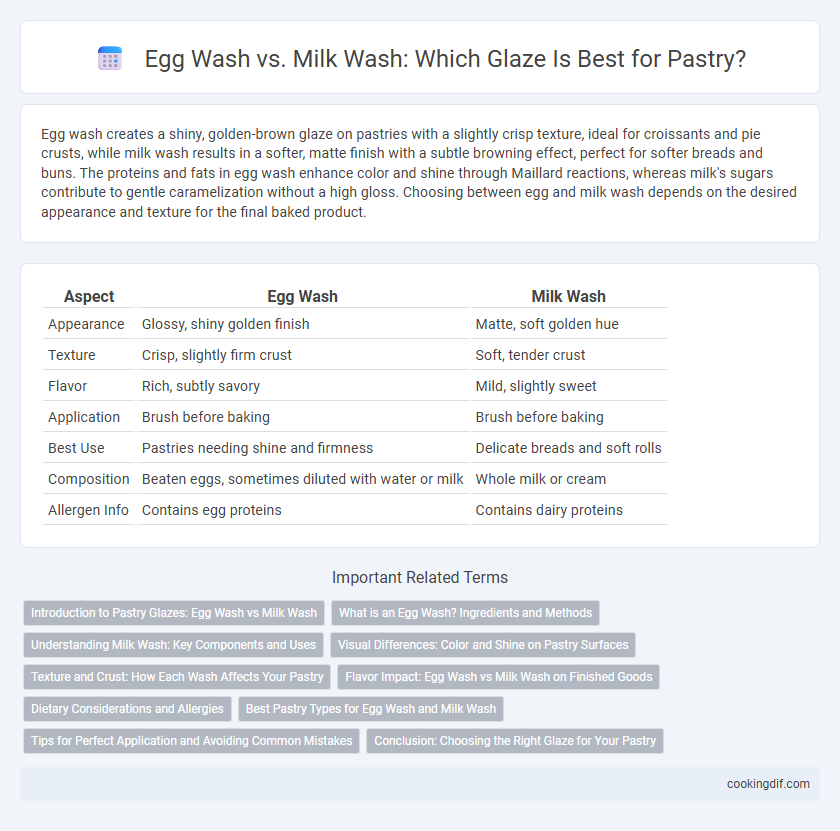Egg wash creates a shiny, golden-brown glaze on pastries with a slightly crisp texture, ideal for croissants and pie crusts, while milk wash results in a softer, matte finish with a subtle browning effect, perfect for softer breads and buns. The proteins and fats in egg wash enhance color and shine through Maillard reactions, whereas milk's sugars contribute to gentle caramelization without a high gloss. Choosing between egg and milk wash depends on the desired appearance and texture for the final baked product.
Table of Comparison
| Aspect | Egg Wash | Milk Wash |
|---|---|---|
| Appearance | Glossy, shiny golden finish | Matte, soft golden hue |
| Texture | Crisp, slightly firm crust | Soft, tender crust |
| Flavor | Rich, subtly savory | Mild, slightly sweet |
| Application | Brush before baking | Brush before baking |
| Best Use | Pastries needing shine and firmness | Delicate breads and soft rolls |
| Composition | Beaten eggs, sometimes diluted with water or milk | Whole milk or cream |
| Allergen Info | Contains egg proteins | Contains dairy proteins |
Introduction to Pastry Glazes: Egg Wash vs Milk Wash
Egg wash and milk wash are two common pastry glazes used to achieve different finishes on baked goods. Egg wash, composed of beaten eggs or eggs mixed with water or milk, creates a shiny, golden-brown crust and enhances browning due to its protein content. Milk wash produces a softer, matte glaze with a subtle browning effect, thanks to the lactose sugars caramelizing gently on the pastry surface.
What is an Egg Wash? Ingredients and Methods
An egg wash is a mixture of beaten eggs, often combined with a small amount of water or milk, brushed onto pastries before baking to create a shiny, golden-brown glaze. Common ingredients include whole eggs, egg yolks for a deeper color, or egg whites for a lighter finish. Techniques vary from applying a thin layer with a pastry brush to achieving different textures and sheens depending on the egg wash concentration and baking time.
Understanding Milk Wash: Key Components and Uses
Milk wash, composed primarily of milk's natural sugars and proteins, imparts a soft, golden sheen on pastries while enhancing browning through lactose caramelization. Its ability to create a subtle, matte finish makes it ideal for delicate baked goods like brioche and scones, where a gentle glaze is preferred. Compared to egg wash, milk wash offers a milder shine and slightly tender crust, contributing to a softer texture without the pronounced glossiness eggs provide.
Visual Differences: Color and Shine on Pastry Surfaces
Egg wash produces a rich, golden-brown color with a glossy, reflective shine on pastry surfaces, enhancing visual appeal and adding depth. Milk wash results in a softer, matte finish with a light, pale golden hue, providing a more subtle and delicate appearance. The choice between egg wash and milk wash significantly affects the pastry's final color intensity and surface shine, influencing presentation and texture perception.
Texture and Crust: How Each Wash Affects Your Pastry
Egg wash creates a glossy, golden-brown crust with a slightly crisp texture, enhancing the overall appearance and crunch of the pastry. Milk wash results in a softer, matte finish and a tender crust, ideal for pastries requiring a delicate surface. Choosing between egg wash and milk wash depends on the desired texture and crust quality, influencing both visual appeal and mouthfeel.
Flavor Impact: Egg Wash vs Milk Wash on Finished Goods
Egg wash imparts a rich, glossy finish with a slightly savory depth, enhancing the golden color and adding a subtle umami flavor to pastries. Milk wash creates a softer sheen with a mild sweetness that subtly enhances the crust's tenderness without overpowering the natural flavors of baked goods. Selecting egg wash or milk wash significantly affects the final taste and appearance, tailored to complement different pastry profiles like savory croissants or sweet rolls.
Dietary Considerations and Allergies
Egg wash, composed primarily of beaten eggs, offers a rich, golden glaze but may trigger allergic reactions in individuals sensitive to egg proteins, making it unsuitable for egg allergies. Milk wash, derived from dairy, provides a softer shine while posing a risk for lactose-intolerant or dairy-allergic consumers due to casein and lactose content. Choosing between egg wash and milk wash depends on specific dietary restrictions, such as egg allergy or lactose intolerance, ensuring safe consumption and desired pastry appearance.
Best Pastry Types for Egg Wash and Milk Wash
Egg wash, composed of beaten eggs sometimes mixed with water or milk, produces a glossy, deep golden finish ideal for savory pastries like empanadas, quiches, and croissants, enhancing their crispiness and color. Milk wash, offering a softer shine and lighter brown hue, suits delicate baked goods such as brioche, scones, and soft rolls, providing a subtle sheen without altering flavor or texture. Choosing the appropriate wash depends on the desired crust color and texture, optimizing the appearance and taste of specific pastry types.
Tips for Perfect Application and Avoiding Common Mistakes
Egg wash creates a shiny, golden-brown glaze with a richer color and crisp texture, making it ideal for pastries that require a vibrant finish. Milk wash offers a subtler shine and softer crust, suitable for delicate baked goods needing gentle browning. For perfect application, use a pastry brush to apply thin, even layers, avoid over-brushing to prevent sogginess, and apply wash just before baking to ensure optimal glaze development.
Conclusion: Choosing the Right Glaze for Your Pastry
Egg wash creates a shiny, golden-brown finish with a rich, slightly crispy texture, ideal for breads and pies that require a vibrant, attractive glaze. Milk wash imparts a softer, matte sheen with a tender crust, perfect for delicate pastries where a subtle, natural finish is preferred. Selecting egg wash or milk wash depends on the desired appearance and texture, ensuring the pastry meets both aesthetic and taste expectations.
Egg wash vs Milk wash for glaze Infographic

 cookingdif.com
cookingdif.com